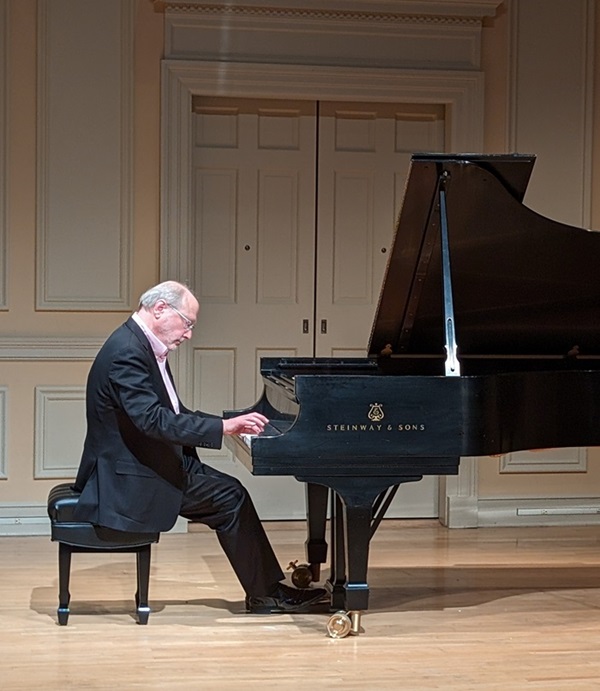Hamelin shares ghostly tales and technical wizardry at Library of Congress

Marc-André Hamelin played Ives’ “Concord” Sonata at the Library of Congress Friday night. Photo: WCR
Every few years, for a couple of decades now, Marc-André Hamelin has appeared in the area with a new program of unexpected and often astoundingly difficult music. The streak continued Friday night when the Canadian-born virtuoso gave a daring recital at the Library of Congress, centered on one of the pinnacles of the 20th century, the Piano Sonata No. 2 (“Concord, Mass., 1840-60”) of Charles Ives.
Hamelin has recorded the “Concord” Sonata twice, both times at astonishing tempi. To hear him play it live—from memory, no less—was a revelation. Ives evoked the time and place of his subtitle through the writings of Ralph Waldo Emerson and other Transcendentalist authors. A sense of mystery and “spiritual immensity,” as Ives once wrote of the piece, permeated the performance.
The first movement (“Emerson”) resounded thunderously in Hamelin’s hands. At both loud and soft dynamics, intertwined lines popped out, including the signature motif from Beethoven’s Fifth Symphony, which runs throughout the sonata. The explosive quality of the forte playing underscored Emerson’s idea of sudden epiphanies, ending on a note of sad resignation.
The most daunting technical challenges came in the second movement (“Hawthorne”). Ives specified that his inspiration came not from that author’s moral texts, such as The Scarlet Letter, but his Gothic stories. Hamelin opted for a hyper-subtle touch with the section requiring “a strip of board 14¾ inches in length.” Drawing forth the wood piece from inside the piano case, he played the indicated clusters almost inaudibly, like a whispering spirit at a séance, while the left hand’s melody came to the fore.
The hymn-like section provided the only respite in this chaotic, almost demonic scherzo, simple triadic chords interrupted by lunatic outbursts, which then dissolved magically back into something like congregational singing. Berserk quotations of “Columbia, Gem of the Ocean” and Ives’ own Country Band March cranked up the intensity of the movement, leading to music-hall antics and walloped five-finger clusters. Accelerating furiously, Hamelin achieved what Ives instructed, that the movement “be played as fast as possible and not too literally.”
A brief respite came in the peaceful third movement (“The Alcotts”), which hovers in and out of tonality, as sentimental as the work of its namesakes, Amos Bronson Alcott and his more famous daughter, Louisa May. This moment of beauty set up the soft-pedaled last movement (“Thoreau”), which Ives wanted to be more quiet in relation to what came before, like the interior thoughts of the solitary writer on Walden Pond.
The only thing this pastoral dreamscape lacked was the optional part for flute, which Hamelin included on his 2004 recording. In this concert, he played the version Ives wrote as an alternative, with the flute melody absorbed into the keyboard. Ives noted that “Thoreau much prefers to hear the flute over Walden,” and the absence was much more regretted than the miniscule viola part toward the end of the first movement, which Hamelin also omitted.
The Library of Congress, celebrating 100 years of its free concert series, commissioned a new piece by Hamelin, Mazurka, heard in its world premiere after intermission. The title alludes to Chopin, echoing his music in the opening right-hand solo roulade, folksy modal harmony, and some lavish fingerwork in parallel thirds. Other elements heard in the rest of the concert cropped up, including Ivesian bitonality and enigmatic melodic motifs like the Schumann and Ravel yet to come. A strangely subdued affair in some ways, the piece grew in stature after some reflection.
Schumann’s Waldszenen offered a romantic twist on themes in the “Concord” Sonata, both the ghost stories of “Hawthorne” and the woodsy serenity of “Thoreau.” Hamelin applied an extremely delicate touch and plenty of rubato, to almost maudlin effect, with ecstatic results in “Freundliche Landschaft” and understated evanescence in “Vogel als Prophet.” Without more virtuosic challenges to unravel, however, the performance felt a little bland.
No such problems with Ravel’s Gaspard de la Nuit, one of the most difficult tours de force ever created. The music narrates three poems by Aloysius Bernard, in a book he claimed came from the devil himself. In the first movement (“Ondine”), the murderous aquatic sprite sang in Hamelin’s left hand, hidden in the gently lapping sounds of his right hand, played with remarkable transparency. Leggiero scales and airy glissandi glistened like misty sprays.
In the second movement (“Le Gibet”), Hamelin’s incredible differentiation of weight and touch gave infinite variation to the layers of sound. The clanging bell, an ostinato B-flat made just slightly different in its octave peal and lighter echo, sounded throughout the movement, seemingly oblivious to the music happening around a corpse hanging on the gallows. The bewildering third movement (“Scarbo”) bristled with tension, as the title demon scampered and then froze in place. The urgent pacing and dynamic contrasts made it clear this was no nursery-rhyme bugbear but a dangerous creature, capable of more than jump scares.
The only part of the recital that defied expectations was the single encore, from a pianist who is known for going overboard in this regard. Hamelin once told an interviewer that he always has “several pieces” prepared and will play “as many as they want, basically.” The audience, regrettably, left with only Hamelin’s “Music Box,” from the collection Con intimissimo sentimento: a demented polytonal waltz, with a very light right hand at odds with a mechanically repeating left hand.
Jonathan Cohen leads Les Violons du Roy in a free concert of baroque music with guitarist MILOŠ, 8 p.m. April 30. loc.gov
